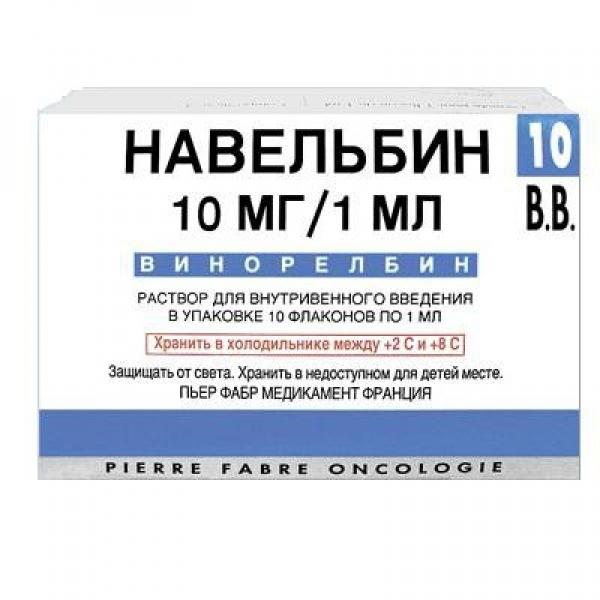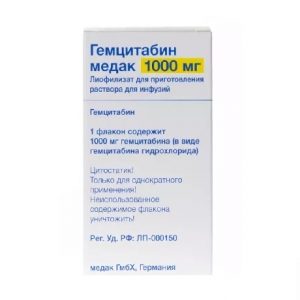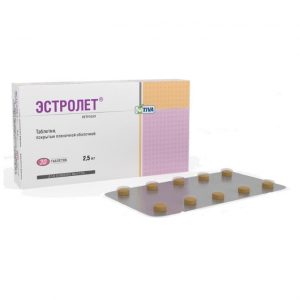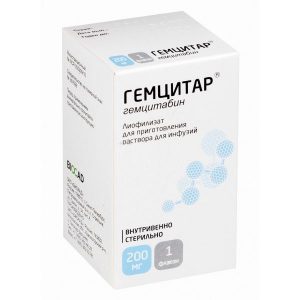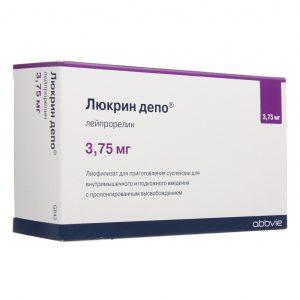Description
Latin name
NAVELBINE
Release form
Concentrate for solution for infusion.
Packaging
In a bottle of 1 ml of concentrate. There are 10 bottles in a thermal container. In a cardboard box 1 thermal container.
Pharmacological action of
Pharmacodynamics of
Antitumor drug from the group of vinca alkaloids (pink vinca alkaloid, obtained semisynthetically). The drug blocks cell mitosis at the stage of G2-M metaphase, causing cell death during interphase or subsequent mitosis. At the molecular level, it affects the dynamic equilibrium of tubulin in the cell microtubule apparatus. Navelbin inhibits tubulin polymerization by binding primarily to mitotic microtubules, and at higher concentrations it also affects axonal microtubules. Induction of tubulin spiralization under the influence of Navelbin is less pronounced than with vincristine.
Pharmacokinetics
Absorption and distribution of
After oral administration, it is rapidly absorbed from the digestive tract. Cmax of vinorelbine is achieved after 1.5-3 hours. The absolute bioavailability is on average 40%. Eating does not affect the degree of absorption.
After iv administration, the kinetics of vinorelbine is a three-phase exponential process.
Plasma protein binding is 13.5%. Intensively binds to blood cells and especially to platelets (78%). It penetrates well into tissues and lingers in them for a long time. High concentrations of vinorelbine are determined in the spleen, liver, kidneys, lungs, and thymus gland, moderate in the heart and muscles, and minimal in adipose tissue and bone marrow. The concentration in the lungs is 300 times the concentration in the plasma. It does not penetrate the BBB.
Metabolism and excretion
Biotransformed in the liver, mainly under the influence of the isoenzyme CYP3A4 with the formation ofThe formation of a number of metabolites, the main one that is determined in the blood, is diacetylvinorelbine, which retains antitumor activity. It is excreted mainly with bile. The average T1 / 2 in the terminal phase is 40 hours (27.7-43.6 hours).
Pharmacokinetics in special clinical cases
Pharmacokinetic parameters of Navelbin (administered at a dose of 20 mg / m2 weekly) do not depend on the age of the patients and do not change in moderate or severe liver failure.
Indications
Non-small cell lung cancer
breast cancer
prostate cancer resistant to hormone therapy (in combination with low doses of corticosteroids for oral administration).
Contraindications
Neutrophil count less than 1,500 / μl
platelet count less than 75,000 / μl (for iv) and less than 100,000 / μl (for oral administration)
severe infections during the start of therapy or transferred during the last two weeks
severe liver function deficiency not associated with the
tumor process need for continuous oxygen therapy in patients with lung tumor
diseases and conditions leading to decreased absorption from the gastrointestinal tract (for oral administration)
pregnancy sr dlkp lactation (breastfeeding)
hypersensitivity to the drug and to other vinca alkaloids.
Precautions: prescribe the drug for respiratory failure, inhibition of bone marrow hematopoiesis (including after previous chemo- or radiation therapy), constipation or symptoms of intestinal obstruction in history, neuropathy in history.
Use during pregnancy and lactation
Navelbin is contraindicated in pregnancy and lactation (breastfeeding).
Composition of
1 ml of concentrate contains:
Active substances: vinorelbine tartrate 13.85 mg, which corresponds to a base content of vinorelbine 10 mg.
Excipients: d / i water, nitrogen (inert gas).
Dosage and administration of
Navelbin is used both as monotherapy and in combination with other antitumor drugs. When choosing a dose and mode of administration in each individual case, you should consult the specialized literature.
Navelbin Concentrate is administered strictly iv in the form of a 6-10 minute infusion.
Capsules are taken orally as a whole, washed down with water without chewing or dissolving them in the mouth.
In monotherapy mode, the usual dose of the drug for iv administration is 25-30 mg / m2 of the body surface once a week. Navelbin is diluted in 0.9% sodium chloride solution or 5% dextrose solution to a concentration of 1.0-2.0 mg / ml (an average of 50 ml). After administration of the drug, the vein should be flushed, introducing an additional at least 250 ml of 0.9% sodium chloride solution or 5% dextrose solution.
For patients with a body surface area of 2 m2 or more, a single dose of Navelbin for iv administration should not exceed 60 mg.
The recommended single dose of Navelbin for oral administration is 60 mg / m2 of body surface once a week. After the third dose, it is recommended to increase the dose to 80 mg / m2.
An increase in the dose from 60 mg / m2 to 80 mg / m2 can be achieved if, during three weeks of taking Navelbin, grade 4 neutropenia (less than 500 / μl) is observed, or there is one episode of grade 3 neutropenia (less than 1000 / μl, but more than 500 / μl), and the number of neutrophils before the next dose is not lower than 1500 / μl.
Minimum number of neutrophils (cells / μl) recorded in the first 3 weeks of taking Navelbin orally at a dose of 60 mg / m2 per week
> 1000
? 500 and
? 500 and
Recommended dose, starting with the 4th dose of
80 mg / m2
60 mg / m2
If, when taking Navelbin at a dose of 80 mg / m2, neutropenia of 4 degrees (less than 500 / μl) or 2 cases of neutropenia of 3 degrees ( less than 1000 / μl, but more than 500 / μl), in the next 3 doses it is necessary to reduce the dose of Navelbin from 80 to 60 mg / m2 per week.
Minimum number of neutrophils (cells / μl) recorded in the first 3 weeks of taking Navelbin orally at a dose of 80 mg / m2 per week
> 1000
? 500 and
? 500 and
<500 Recommended dose starting from the 4th dose of 80 mg / m2 60 mg / m2 If the number of neutrophils has not decreased less than 500 / μl, or more than one decrease in the number of neutrophils has been observed in the range from 500 to 1000 / μl for three weeks of taking Navelbin in a dose of 60 mg / m2 (according to the above recommendations), you can again increase the dose of the drug from 60 to 80 mg / m2 per week. Recommended oral doses of Navelbin depending on the patient s body surface area (BSA) are given in the following table. Body surface area (m2) 60 mg / m2 80 mg / m2 Dose (mg) per week 0.95 to 1, 0 60 1.05 to 1.14 70 1.15 to 1.24 70 1.25 to 1.34 80 1.35 to 1.44 80 1 , 44 to 1.54 90 1.55 to 1.64 100 1.65 to 1.74 100 1.75 to 1.84 110 1.85 to 1.94 110 1.95 or more 120 For patients with BSA 2 m2 or more, the total single dose of Navelbin for oral administration should never exceed 120 mg per week when prescribing the drug at a dose of 60 mg / m2 and 160 mg per week at a dose 80 mg / m2. The use of Navelbin orally in doses of 60 mg / m2 and 80 mg / m2 corresponds to the iv administration of Navelbin in doses of 25 mg / m2 and 30 mg / m2. With polychemotherapy, the dose and frequency of administration of Navelbin (both with iv and oral administration) depend on the specific antitumor therapy program. With a decrease in the number of neutrophils less than 1,500 / μl or platelets less than 75,000 / μl (with iv) or less than 100,000 / μl (when taken orally), the next administration or intake of Navelbin is postponed for 1 week. If due to hematological toxicity it was necessary to refrain from 3 weekly injections or doses of the drug, it is recommended to discontinue the use of Navelbin. Patients with severe hepatic insufficiency, Navelbin should be prescribed with caution, in a dose reduced by 33%. Safety and efficacy of Navelbine in children have not been studied. Special correction of the dosage regimen of Navelbin in the elderly is not required. Side effects The following side effects are more common than in isolated cases. The following criteria were used to assess the incidence of adverse events: very often (> 1/10)
often (> 1 / 100,1 / 10)
sometimes (> 1/1000, 1/100)
rarely (> 1/10 000, 1/1000)
is extremely rare (1/10 000).
From the hemopoietic system: very often – neutropenia, anemia, thrombocytopenia, secondary infections due to inhibition of bone marrow hematopoiesis often – fever (38 ° C) against neutropenia, sometimes – sepsis, septicemia is extremely rare – complicated septicemia, in some cases leading to septicemia fatal outcome. The smallest number of neutrophils is observed on the 7-10th day from the start of therapy, recovery occurs in the next 5-7 days. Cumulation of hematotoxicity was not observed.
From the peripheral nervous system: very often – paresthesia, hyperesthesia, decreased or loss of deep tendon reflexes often – weakness in the legs sometimes – severe paresthesia with sensory and motor symptoms, usually reversible.
From the cardiovascular system: sometimes – increase or decrease in blood pressure, hot flashes and cooling of the extremities rarely – IHD (angina pectoris, myocardial infarction), severe hypotension, collapse very rarely – tachycardia, palpitations, heart rhythm disturbance.
From the respiratory system: sometimes – shortness of breath, rarely bronchospasm – interstitial pneumonia (with combination therapy with mitomycin), acute respiratory distress syndrome.
From the digestive system: very often – nausea, vomiting, stomatitis, constipation, diarrhea, transient increase in liver function tests (ALT, ACT) rarely – pancreatitis, increased bilirubin, intestinal paresis.
On the part of the immune system: rarely – anaphylactic shock, angioedema.
Dermatological reactions: often – alopecia rarely – skin rashes.
Local reactions: often – pain / burning or redness at the injection site, discoloration of the vein, phlebitis upon extravasation – cellulite is possible – necrosis of the surrounding tissues.
Other: often – fatigue, myalgia, arthralgia, fever, pain of various localization, including chest pain, pain in the lower jaw and in the area of tumor formations is rare – hyponatremia is very rare – hemorrhagic cystitis and syndrome of inadequate secretion of ADH.
Drug Interaction
When used together with other cytostatics, mutual aggravation of side effects is possible, first of all – myelosuppression.
When combined with mitomycin C, acute respiratory failure may develop.
When used with paclitaxel increases the risk of neurotoxicity.
Radiation therapy results in radiosensitization. The use of Navelbin after radiation therapy can lead to the re-emergence of radiation reactions.
Concurrent administration of the drug with inducers and inhibitors of cytochrome P450 isoenzymes can lead to changes in the pharmacokinetics of vinorelbine.
Overdose
Symptoms: suppression of bone marrow function, neurotoxic reactions.
Treatment: in case of overdose, the patient should be hospitalized and symptomatic therapy should be carried out with careful monitoring of vital organ functions. The specific antidote is unknown.
Storage conditions
The concentrate for solution for infusion should be stored out of the reach of children, protected from light at a temperature of 2 ° to 8 ° C.
After additional dilution of the concentrate, its physical and chemical stability is maintained for 8 days at room temperature (20 ° ± 5 ° C) or in the refrigerator (at a temperature of 2 ° to 8 ° C).
From a microbiological point of view, the drug should be used immediately after dilution. If the drug has not been administered immediately, the medical professional assumes responsibility for the conditions and duration of its storage until administration. Typically, the duration of such storage should not exceed 24 hours at a temperature of from 2 ° to 8 ° C, except when dilution was carried out under controlled and validated aseptic conditions.
After additional dilution of the drug with saline or glucose solution, the shelf life is 24 hours at room temperature.
The Expiration of
is 3 years.
Deystvuyuschee substances
Vynorelbyn
Dosage Form
Dosage form
infusion solution
